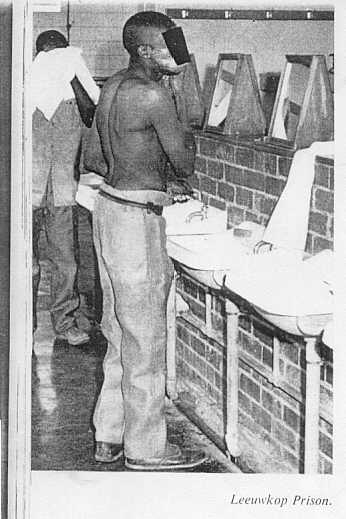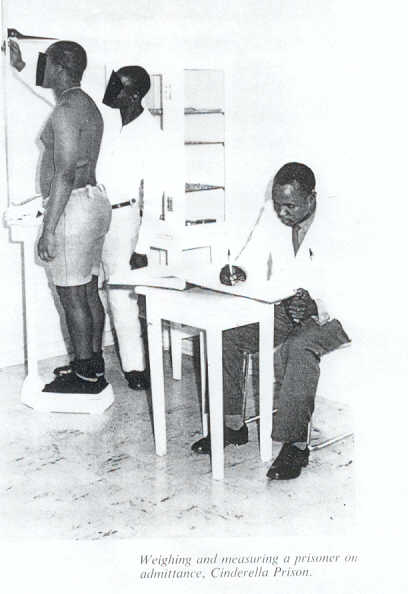|
CONTENTS
5: "PRISON DISCIPLINE" CANINGS Corporal punishment was long in use in South Africa as a sentence for disobedience by prisoners of prison rules. A former South African Judge-President, V.G. Hiemstra, described the rules that prisoners had to observe as a "bewildering system" calculated to make delinquents feel like social outcasts.(1) Act 13 of 1911 empowered prison governors to order a punishment of six cuts if the prisoner was a male apparently under the age of 60 years, and magistrates to order twelve cuts in the same circumstances. This age limit was later reduced to 50 and eventually to 40. Examples of offences against prison discipline included talking, being in possession of food at any time, allowing dust to be found in a cell, and being disrespectful towards a warder. Despite the pettiness of such rules, the punishments could be quite severe. All prisoners, whether convicted or not, were subject to the prison disciplinary regime. Accordingly, prisoners presumed innocent and awaiting trial were subject to the same punishments for infringements of prison discipline as were sentenced prisoners.(2) A large number of specific disciplinary contraventions were listed in the Prisons Regulations. Specific contraventions were committed by any prisoner who:
Commissioned officers generally, or specifically, deputed by the Commissioner had the jurisdiction to try any prisoner for the contravention of any such Prison Regulations. They had the jurisdiction to impose upon conviction a reprimand, the deprivation of one or more meals on any one day, or corporal punishment not exceeding six strokes, provided that the prisoner was a convicted male prisoner apparently under the age of 40 years. On review, the Prison Commissioner could confirm, set aside or alter the sentence. No appeal lay against a sentence imposed by an officer's court on a prisoner (Reg 99(5)). Such trials would usually take place in a courtroom in the prison itself. Only the more serious offences which were also crimes under legislation not concerned specifically with offences in prison would be tried in a court outside the prison. The prisoner had a right to legal representation in either case; however, almost no prisoners in fact had legal assistance if they were charged with further offences (80 to 90 percent of those charged with criminal offences outside prison were unrepresented at trial).
The Prisons Act No 8 of 1959 provided in Section 56(1) that a sentence of corporal punishment imposed by an officer's court was not reviewable by the Supreme Court, nor was there any appeal (section 56(4)), but the Commissioner could request that the record be transmitted to him for review (section 56(5)). On review, the Commissioner could confirm, set aside,or alter the sentence (section 56(5)). These punishments were governed by Prison Regulation No. 100, part of which read as follows:
There are many recorded cases relating to the imposition of corporal punishment for prison disciplinary offences. In R v Jan [1908] TCSR 179 a prisoner was convicted of a breach of Regulation 518 s.13 in making the threat "if you come into the yard I will kill you". He was of previous character, having had 61 convictions, and was sentenced to 7 days solitary confinement, punishment diet, and 12 lashes. In R v Paulus [1932] TPD 249 (Transvaal) the defendant, a convicted prisoner in gaol, struck the Head Warder with his fist. He had 17 sentences in gaol for fighting, insolence, and other breaches of regulations. In each case he had been given solitary confinement and spare diet. In May 1923 he assaulted and stabbed a native with a knife. He pleaded guilty and was awarded 6 months and 10 strokes. The Judge on appeal wrote:
R v Kumalo [1951] 1 SA 451 concerned the Farm Colonies Regulations. The prisoner, an inmate of Leeuwkop Farm Colony, contravened Regulation 421(1)(8) in a minor assault on a fellow inmate. He hit him in the face with his fist and stabbed him in the buttock with a spoon. He pleaded guilty and was sentenced to receive 6 strokes with a cane and to forfeit 90 good conduct marks. Regulation 36 enabled punishment of offences in the Colony by means of corporal punishment of not more than 12 strokes, and Regulation 135 provided for corporal punishment of not greater than 6 strokes, if the prisoner was a convict male under 60 years. 
R v Maphumulo [1960] 2 SA 793 considered the punishment of 43 prisoners who had refused to perform their prison duties in contravention of Prison Regulation 99(1) (Govt. Gazette 6375). They were inmates of Durban Central Prison detained under the pass laws. On 28 August 1959 they refused to work after being ordered to do so. Each pleaded guilty. 41 were sentenced to receive 5 strokes with a cane and 2 were sentenced to 7 days solitary of which 6 were to be on spare diet. They contended that they could not be forced to work under Reg. 4 as they were held for examination only. On review, the court held that defendants 2 and 7 were to receive 3 days solitary confinement, suspended for 6 weeks. In relation to the other defendants (who had been awarded whippings) and whose ages ranged from under 21 (the majority) to 40, all sentences were altered to 3 strokes, suspended for 6 weeks. The court said that if they further breached their obligation to perform labour they would get the strokes, but otherwise not. S v Kruger [1963] 3 SA 43 (Orange) dealt with the case of a prisoner who was awarded 6 cuts for refusal to put out a cigarette. The sentence was confirmed. In S v Abrahams [1966] (2) SA (Cape) a charge of sodomy attracted a sentence of six cuts, which was confirmed on review. In the 1970s the amount of prison corporal punishment was reduced considerably. In the year ended 30 June 1976 there were 2,251 whippings (609 of juveniles and 1,642 of adults), of which 331 were for prison discipline and 442 were court sentences of whipping without imprisonment. 1,478 were court sentences of corporal punishment combined with a prison term. In S v Mbele [1974] 1 SA 705, a 26-year-old prisoner convicted of a petty assault on a fellow prisoner was sentenced to receive "6 strokes with a heavy cane". The sentence was set aside. In S v Williams [1978] 1 SA 1177 (Cape), a prisoner aged 31 had been sentenced by a correctional officer under s.54 of the Prisons Act 8/59 to receive 6 cuts for a serious assault on another prisoner. The court examined corporal punishment in detail in its decision. It found that Act 51/77 provided that no person over 30 could be sentenced by a court to whipping. The conviction was confirmed but the sentence was accordingly set aside. However, this finding was repudiated in S v De Kock [1979] 3 SA 806 (Orange). A white prisoner at Greens Point Prison was convicted of the prison offence of "impertinence and unrespectful conduct" towards an officer. He was awarded 6 cuts despite the sentencing officer's request to have the sentence suspended in full. On review, the punishment was confirmed. The court found that an officers' court had no jurisdiction to suspend a sentence of corporal punishment (Prisons Act 8/59). The judge in this case disagreed with the decision in S v Williams (see above), which, he said, "loses sight of the fact that in terms of s.54(2)(d) of the Prisons Act express provision is made for the imposition of corporal punishment up to the age of 40 years". He held that Act 51/77, with its reference to an age limit of 30, did not apply to prison discipline CP. 
In S v Saayman [1987] (2) SA 504 (Cape) a prisoner was sentenced to cuts for mutilating his prison identity card by writing on it and for failing to remove a duster, which he had worn as a scarf, promptly enough on being ordered to do so. In S v November [1988] 1 SA 661 (Cape), two prisoners were sentenced to receive 6 cuts each for failing to affix their fingerprints in a register reflecting the particulars of prisoners who had been subjected to rectal examinations in search of "illegal articles". The reviewing court questioned the legality of the command to affix the fingerprints in the register but the conviction was confirmed. In S v Dlakiya [1988] (1) SA 574 (Transvaal) a 31-year-old prisoner was convicted of a petty assault and sentenced to six cuts. The court questioned the disparity in maximum age limits for corporal punishment –- if it had been a non-prison offence the prisoner would have been too old for the cane -- but pointed out that only the legislature could amend it. The court amended the sentence by replacing it with three cuts. As a result of court supervision which severely restricted its application, prison corporal punishment was little used in this era. The figures are shown in the table below:(3)
The power to inflict corporal punishment for prison disciplinary offences was legally removed with the 23 June 1993 amendment to the Correctional Services Act. The amendments did not come into effect until March 1994, and the punishments to be abolished were still being applied at the end of 1993.(4) The amendments brought South Africa into line with UN Standard Minimum Rules: "Corporal punishment, punishment by placing in a dark cell, and all cruel, inhuman or degrading punishments shall be completely prohibited as punishments for disciplinary offences." FOOTNOTES
|

 The prison at Port Elizabeth (from Prison Administration in South Africa, S.A. Prisons Department)
The prison at Port Elizabeth (from Prison Administration in South Africa, S.A. Prisons Department)